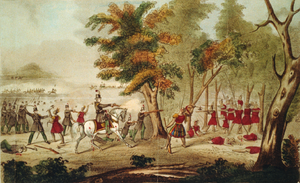Battle of Moraviantown
| Battle of the Thames | |||||||
|---|---|---|---|---|---|---|---|
| Part of Tecumseh's War and the War of 1812 | |||||||
 An artist's depiction of the battle and the death of Tecumseh. |
|||||||
|
|||||||
| Belligerents | |||||||
|
Tecumseh's Confederacy |
|
||||||
| Commanders and leaders | |||||||
|
Tecumseh † |
|
||||||
| Strength | |||||||
|
1,300-1,600:
|
3,760+:
|
||||||
| Casualties and losses | |||||||
|
Native Americans: 16-33 killed Unknown wounded and captured British: 12-18 killed 22-35 wounded prisoners 566-579 captured |
10-27 killed 17-57 wounded |
||||||
Coordinates: 42°33′45″N 81°55′53″W / 42.56250°N 81.93139°W
American victory
1,300-1,600:
3,760+:
The Battle of the Thames, also known as the Battle of Moraviantown, was a United States victory in the War of 1812 against the United Kingdom and Tecumseh's Confederacy. It took place on October 5, 1813 in Upper Canada, near present-day Chatham, Ontario.
British troops under Major General Henry Procter had occupied Detroit until the U.S. Navy gained control of Lake Erie, depriving them of their supplies. Procter was forced to retreat north up the river Thames to Moraviantown, where his allies, the tribal confederacy under Shawnee leader Tecumseh and war chief Roundhead (Wyandot), had no choice but to follow. American infantry and cavalry under Major General William Henry Harrison drove off the outnumbered British and then defeated the Native warriors, who were demoralised by the deaths of Tecumseh and Roundhead in action. American control over the Northwest frontier was re-established, the tribal confederacy collapsed, and Procter would later be court-martialled for his poor leadership.
During the last months of 1812 and for much of 1813, the American Army of the Northwest under William Henry Harrison was attempting to recover Detroit and capture Fort Amherstburg at Amherstburg from the Right Division of the British Army in Upper Canada, which was commanded by Major General Henry Procter.
...
Wikipedia
